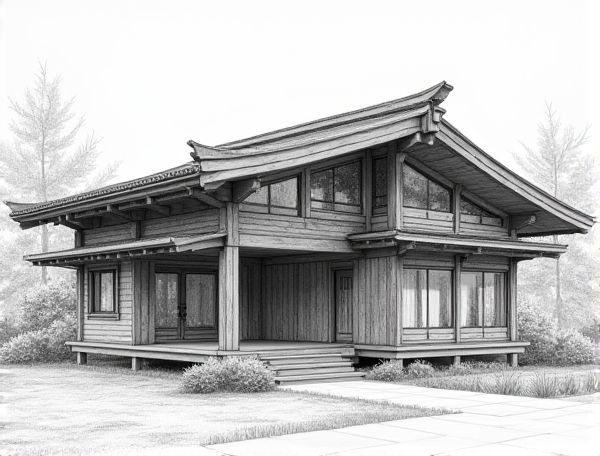
Photo illustration: Japandi home design with burnt cedar siding (shou sugi ban)
Japandi home design seamlessly blends Japanese minimalism and Scandinavian warmth, enhanced by the rich, textured appeal of burnt cedar siding (shou sugi ban) that offers durability and natural beauty. Explore how incorporating this sustainable technique can elevate Your home's aesthetic and longevity by reading more in the article.
Introduction to Japandi Home Design
Japandi home design blends Japanese minimalism with Scandinavian functionality, creating a serene and practical living space. Emphasizing natural materials such as wood, bamboo, and linen, it brings warmth and simplicity while maintaining a clutter-free environment. Neutral color palettes combined with clean lines and handcrafted details promote tranquility and timeless elegance in interior decor.
The Essence of Japandi Aesthetics
Japandi aesthetics combines the minimalist elegance of Japanese design with the warm, cozy elements of Scandinavian style, creating a harmonious space that emphasizes natural materials, clean lines, and functional beauty. Your home will benefit from this blend by fostering tranquility and simplicity while embracing comfort and natural light.
What Is Burnt Cedar Siding (Shou Sugi Ban)?
Burnt cedar siding, known as Shou Sugi Ban, is a traditional Japanese technique that involves charring cedar wood surfaces to create a durable, weather-resistant exterior cladding. This process enhances the wood's natural resistance to rot, insects, and fire while providing a distinct textured appearance that ages beautifully over time.
Historical Roots of Shou Sugi Ban
The historical roots of Shou Sugi Ban trace back to 18th-century Japan, where this wood preservation technique was developed to protect cedar siding from fire, insects, and weathering, enhancing durability and aesthetics. You can incorporate this traditional method to achieve a timeless, charred wood finish that blends cultural heritage with modern home design.
Benefits of Burnt Cedar in Modern Japandi Homes
Burnt cedar offers exceptional durability and weather resistance, making it ideal for modern Japandi homes that emphasize natural materials and longevity. Its rich, textured finish enhances the minimalist aesthetic typical of Japandi design, blending traditional Japanese wabi-sabi with Scandinavian simplicity. The natural charred surface also provides a sustainable, low-maintenance option that resists insects and decay without chemical treatments.
Combining Minimalism and Warmth with Shou Sugi Ban
Combining minimalism and warmth in home design with Shou Sugi Ban creates a striking balance between sleek simplicity and natural texture through its charred wood finish. This traditional Japanese technique enhances durability while adding rich, organic tones that complement modern minimalist spaces. Your living environment benefits from both the aesthetic appeal and functional resilience of Shou Sugi Ban, fostering a cozy yet contemporary atmosphere.
Sustainable Features of Burnt Cedar Siding
Burnt cedar siding offers exceptional sustainability by utilizing naturally rot-resistant wood that requires minimal chemical treatment, reducing environmental impact. Its carbon-negative production process sequesters more carbon than it emits, promoting eco-friendly construction practices. The material's durability and low maintenance extend the lifespan of home exteriors, minimizing replacement needs and waste generation.
Integrating Shou Sugi Ban with Japandi Interiors
Integrating Shou Sugi Ban with Japandi interiors enhances minimalist spaces by blending traditional Japanese wood charring techniques with Scandinavian simplicity, creating a warm yet sleek aesthetic. The deep, textured blackened wood contrasts beautifully with light, natural materials like bamboo, linen, and oak, while emphasizing sustainability and durability. This fusion highlights clean lines and organic textures, producing a serene, balanced atmosphere ideal for modern, functional living spaces.
Maintenance Tips for Burnt Cedar Facades
Regularly inspect your burnt cedar facade for signs of peeling, cracking, or discoloration to maintain its unique aesthetic and protect the wood. Clean the surface with a soft brush and mild detergent to remove dirt and prevent mold growth without damaging the burnt layer. You can extend the life of your facade by applying a clear, UV-resistant sealant every few years to shield against moisture and sun exposure.
Inspiring Japandi Homes Featuring Shou Sugi Ban
Japandi homes masterfully blend Scandinavian minimalism with Japanese elegance, highlighted by the unique Shou Sugi Ban technique, which uses charred wood for both durability and aesthetic appeal. This eco-friendly method enhances wood's natural resistance to weather and pests, creating a striking contrast of deep blackened textures against clean, simple lines. Your interior will exude warmth and modern sophistication, making every space a serene and inspiring retreat.
 homedesy.com
homedesy.com